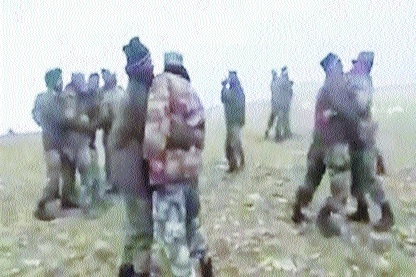Fierce scuffle kills 43 Chinese at LAC
17 Jun 2020 00:57:49

Clockwise from left, Colonel Santosh Babu, Sepoy Ojha and Havildar Palani, who were martyred during a clash with Chinese troops in Ladkah on Monday night. (PTI)
NEW DELHI,
As many as 20 soldiers make supreme sacrifice for India' First such incident involving fatalities after a gap of 45 years and signalling a massive escalation in the border standoff
A VIOLENT face-off with Indian soldiers in Ladakh’s Galwan Valley has left China with a bloodied nose, on Monday. As many as 43 on the Chinese side suffered casualties including dead and some seriously injured. A total of 20 Indian Army personnel were killed during the clash with Chinese troops, escalating the already volatile border stand-off between the two sides. Indian intercepts revealed that the Chinese side was the worst hit in the fierce physical skirmish that happened on late evening and night of June 15 in Ladakh's Galwan Valley as a result of an attempt by the Chinese troops to “unilaterally change” the status quo during de-escalation in Eastern Ladakh.
The situation could have been avoided if the agreement at the higher level been scrupulously followed by the Chinese side, India said on Tuesday. Initially, the army said one officer and two soldiers were killed. Later in the night, an army statement said 17 more soldiers who “were critically injured in the line of duty at the stand off location and exposed to sub-zero temperatures in the high altitude terrain have succumbed to their injuries, taking the total that were killed in action to 20.”
“Indian and Chinese troops have disengaged at the Galwan area where they had earlier clashed on the night of 15/16 June 2020,” it said, adding that the “Indian Army is firmly committed to protect the territorial integrity and sovereignty of the nation. Multiple sources in government and military establishments told PTI that the fierce clashes continued for several hours. It has been learnt that rival soldiers exchanged blows, threw stones at each other and Chinese troops even attacked Indian soldiers with rods and nail-studded clubs during the brawl. However, this wasn’t the first time the two armies engaged in fisticuffs or used stones and rods to attack each other in the area.
The sources said the Chinese side also suffered “proportionate casualties” but chose not to speculate on the numbers. However, the State-run ‘Global Times’ admitted heavy damage to the Chinese troops during the physical exchange. Defence Minister Rajnath Singh briefed Prime Minister Narendra Modi about the clash as well the overall situation in eastern Ladakh after he held a high-level meeting with External Affairs Minister S Jaishankar, Chief of Defence Staff Gen Bipin Rawat and the three service chiefs. According to a senior military officer, it is the first incident involving the casualty of an Indian soldier in a violent clash with the Chinese Army after 1975 when four Indian soldiers were killed in an ambush at Tulung La in Arunachal Pradesh. Military sources said the two armies held major general-level talks at the site of the clash. “During the de-escalation process underway in the Galwan Valley, a violent face-off took place on Monday night with casualties. The loss of lives on the Indian side includes an officer and two soldiers,” the Army said in a brief statement.

Indian and Chinese troops engaged in a fierce scuffle on LAC.
(File photo)
\
China tried to unilaterally change status quo in Ladakh: MEA
New Delhi,
JUNE 16 (IANS)
INDIA on Tuesday hit out at China for unilaterally attempting to change the status quo along the Line of Actual Control (LAC) in Eastern Ladakh, which led to the killings of troops of both the countries in a violent clash on Monday night. The Ministry of External Affairs’ official spokesperson Anurag Srivastava said that on Monday late-evening, a violent face-off erupted between the two sides because of “an attempt by the Chinese side to unilaterally change the status quo” in the Galwan Valley in Ladakh. “Both sides suffered casualties that could have been avoided had the agreement at the higher level been scrupulously followed by the Chinese side,” Srivastava said.
He was responding to media queries on the situation in the western sector of the India-China border. India and China, the spokesperson said, have been discussing through military and diplomatic channels the de-escalation of the situation in Eastern Ladakh. Senior Commanders had a productive meeting on June 6 and agreed on a process for such de-escalation. Subsequently, ground commanders had a series of meetings to implement the consensus reached at the higher level. “While it was our expectation that this would unfold smoothly, the Chinese side departed from the consensus to respect the Line of Actual Control (LAC) in the Galwan Valley,” the Government spokesperson said. India, he said, is known for its responsible approach to border management and has been very clear that all its activities are always within the Indian side of the LAC. “
We expect the same from the Chinese side,” he said. The Government, he said, remains firmly convinced of the need for the maintenance of peace and tranquillity in the border areas and the resolution of differences through dialogue. At the same time, the government is also “strongly committed to ensuring India’s sovereignty and territorial integrity,” he said.